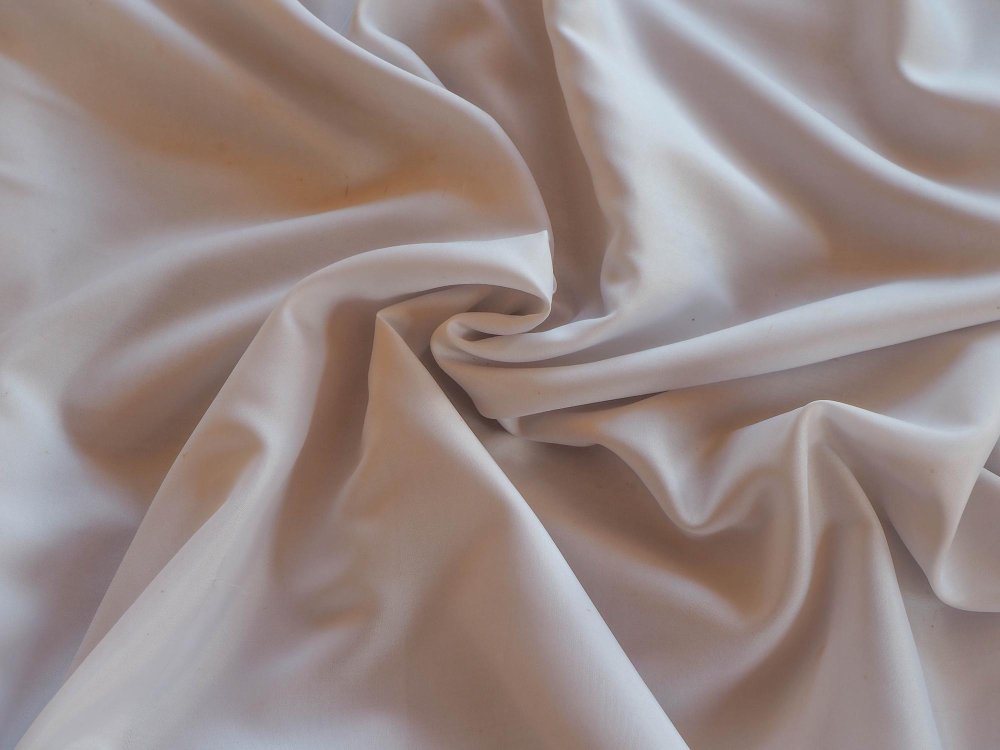Everything you need to know about sateen fabric, from its silky-smooth weave and sustainability to care instructions, comparisons, and expert buying tips
Table of Contents
- What is Sateen Fabric?
- The History of Sateen
- Understanding the Sateen Weave
- What Sateen is Made From
- The Mercerization Process
- Key Properties and Characteristics
- Sateen vs Percale: Complete Comparison
- Sateen vs Satin: Clearing the Confusion
- Sateen vs Silk: Which is Better?
- Environmental Impact and Sustainability
- Organic Cotton Sateen
- Important Certifications
- Uses for Sateen Fabric
- Complete Care Guide
- Advantages and Disadvantages
- How to Choose Quality Sateen
- Frequently Asked Questions
- Conclusion
What is Sateen Fabric?

Sateen is a type of cotton fabric woven using a special satin weave pattern that creates a smooth, lustrous surface with a subtle sheen. Unlike satin, which refers to silk or synthetic materials woven in this pattern, sateen specifically describes cotton fabric woven with this technique. The result is an affordable, durable fabric that mimics the luxurious feel of silk without the high price tag.
The name “sateen” comes from “satin,” which itself derives from the Arabic word “Zaytuni,” referring to the Chinese port city of Quanzhou where silk satin was first exported over 2,000 years ago. When cotton manufacturers wanted to create a similar look and feel using cotton fibers instead of silk, sateen was born.
Quick Definition
Sateen is a weave, not a material. It’s cotton (or occasionally other fibers) woven in a 4-over-1-under pattern that creates more thread exposure on the surface, resulting in that signature smooth, slightly shiny finish.
What Kind of Fabric is Sateen?
Sateen is classified as a woven fabric, specifically a type of satin weave applied to cotton or cotton-blend yarns. It’s different from knitted fabrics like jersey or stretchy materials. The weave structure makes sateen denser and more substantial than plain-weave cottons like muslin or lawn.
Most sateen fabrics are made from 100% cotton, particularly long-staple varieties like Egyptian cotton or Pima cotton. However, you’ll also find sateen made with:
- Organic cotton for eco-conscious shoppers
- Cotton blends with polyester for added durability
- Rayon or bamboo for enhanced drape and softness
- Cotton with elastane for stretch sateen used in fitted clothing
Is Sateen Natural or Synthetic?
Sateen is typically a natural fabric because it’s most commonly made from 100% cotton. Cotton is a plant-based, natural fiber that’s biodegradable and renewable. However, the term “sateen” refers to the weave pattern, not the fiber content, so you might occasionally find sateen woven from synthetic or blended materials.
The Fascinating History of Sateen
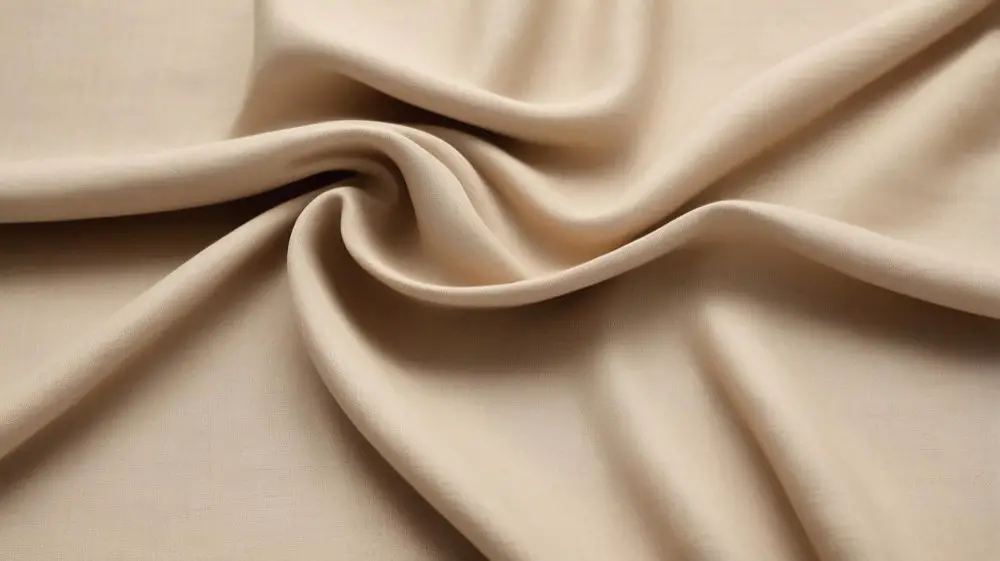
The story of sateen begins with satin, which originated in ancient China over 2,000 years ago. Chinese artisans developed the satin weave to showcase silk’s natural luster and smooth texture. This luxurious fabric was highly prized and became a major export along the Silk Road trade routes.
By the 12th century, satin weaving techniques had spread through the Middle East and into Europe. However, silk satin remained expensive and available only to the wealthy. During the 18th and 19th centuries, textile manufacturers began experimenting with applying the satin weave to cotton fibers, creating what we now call sateen.
The Industrial Revolution changed everything. Mechanized looms made it possible to produce sateen at scale, making this luxurious-feeling fabric accessible to the growing middle class. By the late 19th and early 20th centuries, sateen had become popular for both home textiles and fashion in Europe and America.
Today, sateen continues to be one of the most sought-after fabrics for bedding, with sateen sheets competing with percale as the top choice for premium bed linens.
Understanding the Sateen Weave
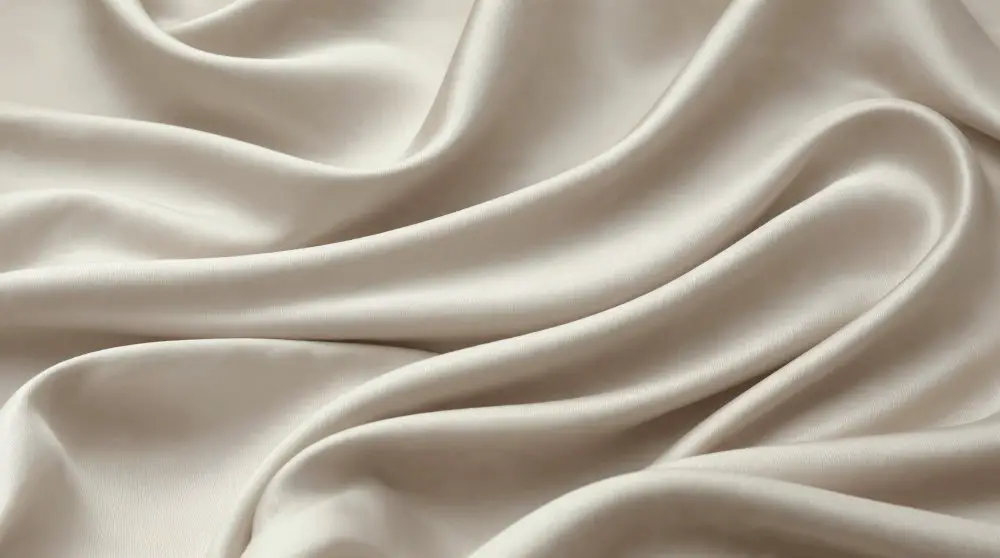
The magic of sateen lies in its weave structure. While this might sound technical, understanding how sateen is woven helps explain why it feels and looks the way it does.
The 4-Over-1-Under Pattern
Sateen uses what’s called a “four-over, one-under” weave pattern. Here’s what that means:
- Warp threads run vertically (lengthwise) on the loom
- Weft threads run horizontally (widthwise) across the fabric
- In sateen, each weft thread passes over four warp threads before going under one
This pattern creates longer “floats” where threads run along the surface without interlacing. These floats are what give sateen its smooth texture and subtle shine. The more surface thread you see, the softer and more lustrous the fabric feels.
Comparing Weave Patterns
To understand sateen better, let’s compare it to other common weaves:
| Weave Type | Pattern | Characteristics | Common Uses |
|---|---|---|---|
| Plain Weave | 1-over, 1-under | Crisp, matte, breathable, durable | Muslin, poplin, percale |
| Sateen Weave | 4-over, 1-under | Smooth, lustrous, soft, drapes well | Sateen sheets, dresses, linings |
| Twill Weave | Diagonal pattern | Strong, textured, wrinkle-resistant | Denim, chinos, gabardine |
What Sateen is Made From
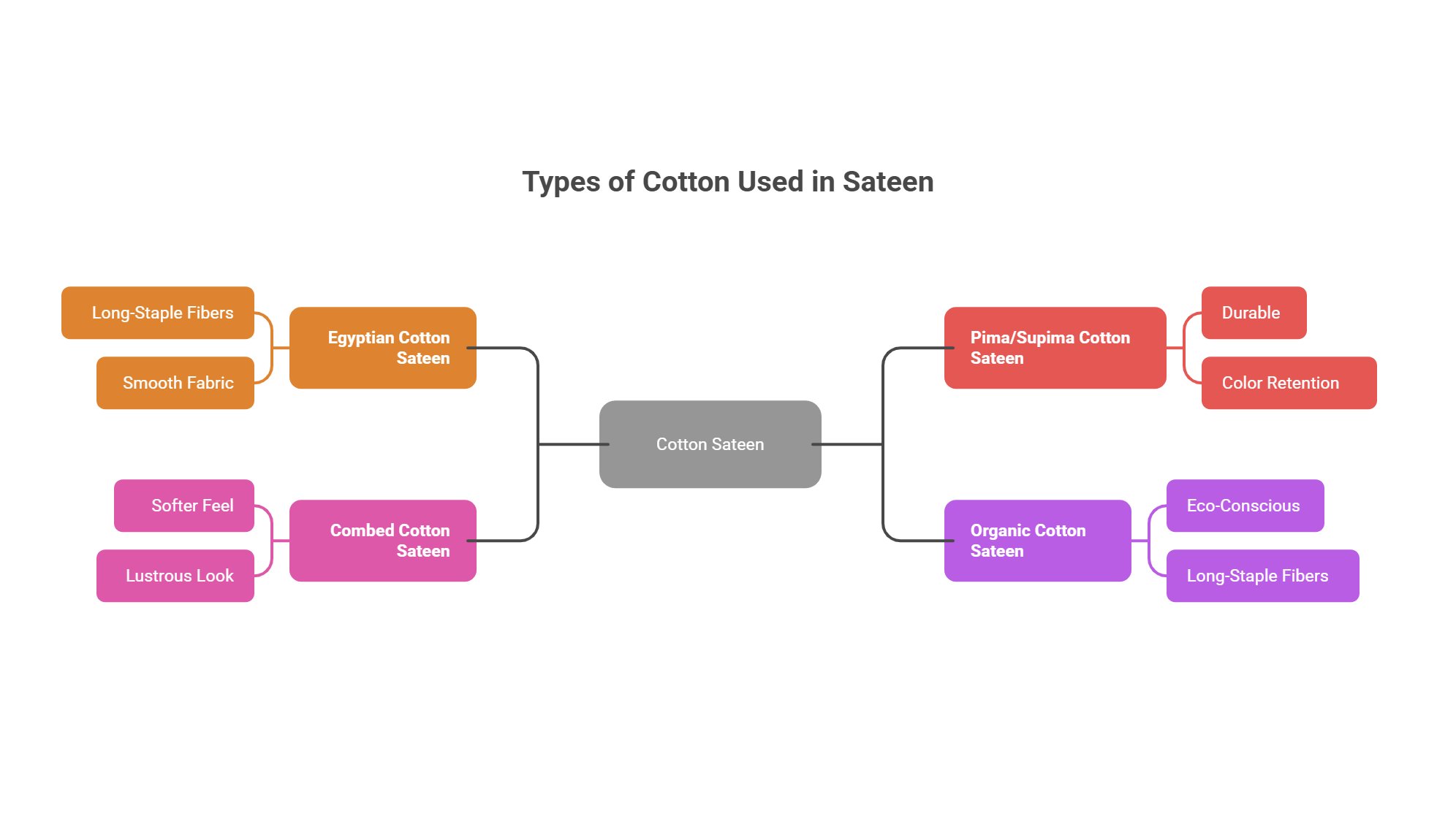
Is Sateen 100% Cotton?
Most quality sateen fabrics are indeed 100% cotton. Pure cotton sateen offers the best combination of softness, breathability, and durability. However, “sateen” refers to the weave, not the fiber content, so not all sateen is pure cotton.
Types of Cotton Used in Sateen
Egyptian Cotton Sateen: Made from long-staple cotton fibers grown in Egypt, this is considered premium sateen. The extra-long fibers (sometimes over 2 inches) create an exceptionally smooth, strong fabric with minimal pilling.
Pima/Supima Cotton Sateen: Pima cotton, particularly the American-grown Supima variety, offers similar quality to Egyptian cotton. It’s smooth, durable, and has excellent color retention.
Combed Cotton Sateen: Regular cotton that’s been combed to remove shorter fibers. This process creates smoother, more uniform yarns that feel softer and look more lustrous.
Organic Cotton Sateen: Grown without synthetic pesticides or fertilizers, organic cotton sateen appeals to eco-conscious consumers. The quality can match conventional cotton when made from long-staple organic fibers.
Cotton Sateen Blends
Some sateen fabrics blend cotton with other fibers:
- Cotton-Polyester Sateen: Adds durability and wrinkle resistance, but reduces breathability
- Cotton-Rayon Sateen: Increases drape and sheen, popular for fashion applications
- Stretch Sateen: Contains 2-5% elastane or spandex for fitted garments like pants and jackets
The Mercerization Process
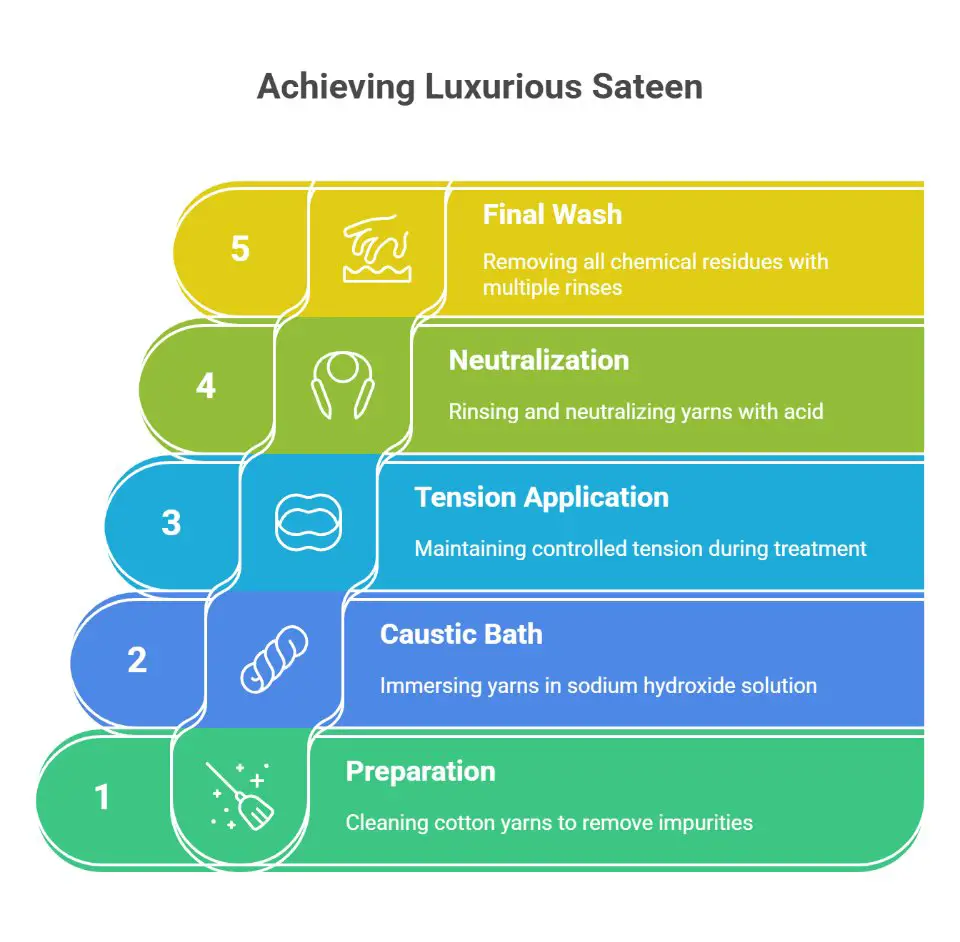
High-quality sateen often undergoes a treatment called mercerization, which significantly improves the fabric’s properties. Understanding this process helps explain why some sateen feels more luxurious than others.
What is Mercerization?
Mercerization is a chemical treatment developed in 1844 by John Mercer. The process involves treating cotton yarns with a sodium hydroxide (caustic soda) solution under tension. This transforms the cotton fibers at a molecular level.
The Mercerization Steps
- Preparation: Cotton yarns are cleaned to remove natural oils and impurities
- Caustic Bath: Yarns are immersed in sodium hydroxide solution (typically 20% concentration)
- Tension Application: The yarns are kept under controlled tension during treatment
- Neutralization: After 20 seconds (optimal time), yarns are rinsed and neutralized with acid
- Final Wash: Multiple rinses remove all chemical residues
Benefits of Mercerized Sateen
- Enhanced Luster: The treatment makes cotton fibers more reflective, creating a silk-like shine
- Increased Strength: Mercerized cotton is up to 20% stronger than untreated cotton
- Better Dye Absorption: Colors appear more vibrant and resist fading
- Mildew Resistance: The treatment makes fabric less susceptible to mildew
- Reduced Shrinkage: Mercerized sateen maintains its size better after washing
Key Properties and Characteristics
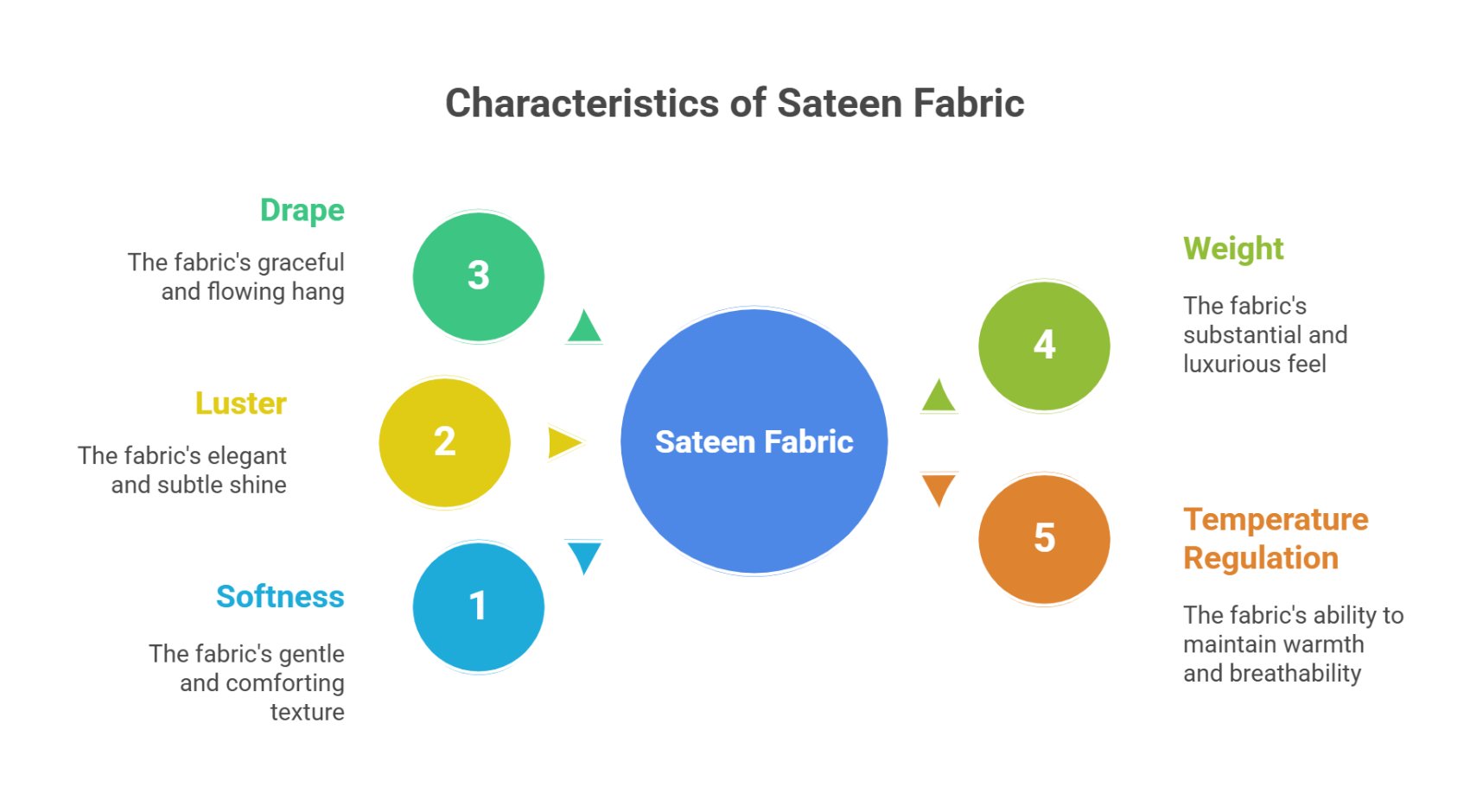
What Does Sateen Fabric Feel Like?
If you’ve never touched sateen, imagine the smoothness of silk fabric but with more body and weight. Sateen has a buttery-soft texture that glides across your skin. The surface feels almost polished, with no roughness or texture. When you run your hand over sateen, it’s cool to the touch and has a slight resistance that makes it feel substantial and luxurious.
Does Sateen Feel Like Satin?
Yes and no. Both sateen and satin share a smooth, somewhat slippery surface texture. However, sateen (being cotton-based) feels less slippery than synthetic satin. It has more grip and body, while still maintaining that silky-smooth character. Sateen also feels more natural and less “plasticky” than polyester satin.
Key Characteristics of Sateen
Softness: Sateen ranks among the softest cotton fabrics. The weave exposes more thread surface, and when combined with long-staple cotton, the result is exceptional softness that often improves with washing.
Luster and Sheen: Sateen has a gentle, sophisticated sheen rather than a high-gloss shine. The luster comes from light reflecting off the long thread floats on the surface. This gives sateen an elegant appearance without looking overly shiny.
Drape: Due to its looser weave structure, sateen drapes beautifully. It flows and hangs in soft folds rather than standing stiffly. This makes it perfect for clothing that needs graceful movement and bedding that should conform to your body.
Weight: Sateen typically weighs more than plain-weave cottons of similar thread count. This heavier weight contributes to the luxurious feel and helps the fabric hang properly in garments or lie smoothly on a bed.
Temperature Regulation: Sateen is moderately breathable but retains more warmth than percale. The denser weave traps some air, making sateen sheets cozy in cooler weather while still allowing some airflow.
Is Sateen Fabric Breathable?
Sateen is moderately breathable. While it’s more breathable than synthetic fabrics, it’s not as breathable as plain-weave cottons like percale. The tighter, denser weave structure means less air circulates through the fabric. This makes sateen warmer and better suited for cool sleepers or colder climates, but potentially too warm for hot sleepers or summer weather.
Is Sateen Warmer Than Cotton?
This question contains a common misconception. Sateen IS cotton, just woven differently. The real question is whether sateen is warmer than other cotton weaves like percale. The answer is yes. Sateen’s denser weave and heavier weight trap more body heat compared to lighter, looser cotton weaves. If you’re asking whether sateen is warmer than regular plain-weave cotton, the answer is also yes.
Sateen vs Percale: The Ultimate Comparison
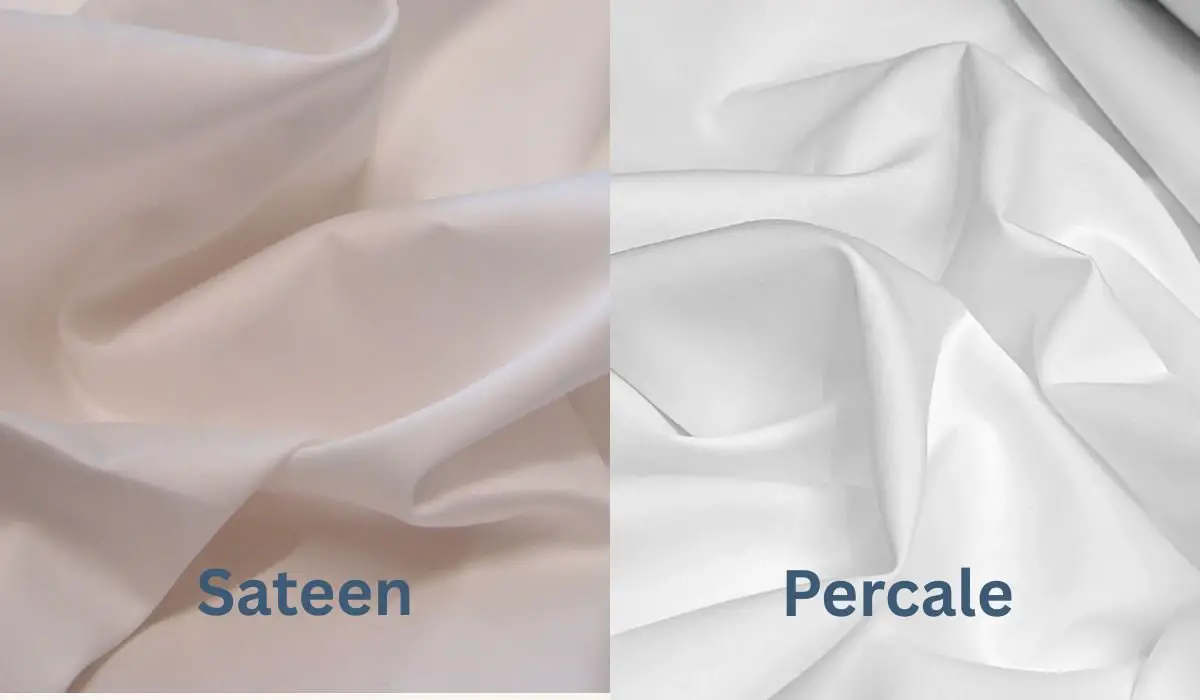
When shopping for premium cotton bedding or fabric, you’ll often see sateen and percale as the two main options. Both are high-quality, but they offer very different experiences. According to Sleep Foundation experts, understanding these differences helps you choose the right sheets for your sleep style. Let’s break down exactly how they compare.
The Main Differences
| Feature | Sateen | Percale |
|---|---|---|
| Weave Pattern | 4-over, 1-under (or 3-over, 1-under) | 1-over, 1-under (plain weave) |
| Surface Texture | Smooth, silky, lustrous | Crisp, matte, slightly textured |
| Feel | Soft, buttery, substantial | Cool, crisp, lightweight |
| Sheen | Subtle luster | Matte finish |
| Weight | Heavier, denser | Lighter, airier |
| Warmth | Warmer, retains heat | Cooler, more breathable |
| Breathability | Moderate | Excellent |
| Durability | Good, may pill over time | Excellent, very durable |
| Wrinkle Resistance | Excellent, naturally wrinkle-resistant | Poor, wrinkles easily |
| Best For | Cold sleepers, winter, luxurious feel | Hot sleepers, summer, crisp feel |
| Thread Count | 300-600 (optimal) | 200-400 (optimal) |
| Price Range | Moderate to high | Moderate to high |
Do Hotels Use Sateen or Percale?
Most luxury hotels prefer percale sheets. The crisp, cool feel of percale is refreshing and has that classic hotel sheet experience guests expect. Percale is also more durable under commercial laundering conditions and shows less wear over time. However, some boutique hotels use sateen for a softer, more luxurious feel. The choice often depends on the hotel’s target market and climate.
Which Should You Choose?
Choose sateen if you:
- Sleep cold or live in a cooler climate
- Prefer soft, silky textures
- Want wrinkle-resistant sheets
- Like a cozy, substantial feel
- Appreciate a subtle sheen
Choose percale if you:
- Sleep hot or live in a warm climate
- Prefer crisp, cool textures
- Want maximum breathability
- Like lightweight bedding
- Prefer a matte, classic look
Sateen vs Satin: Clearing the Confusion
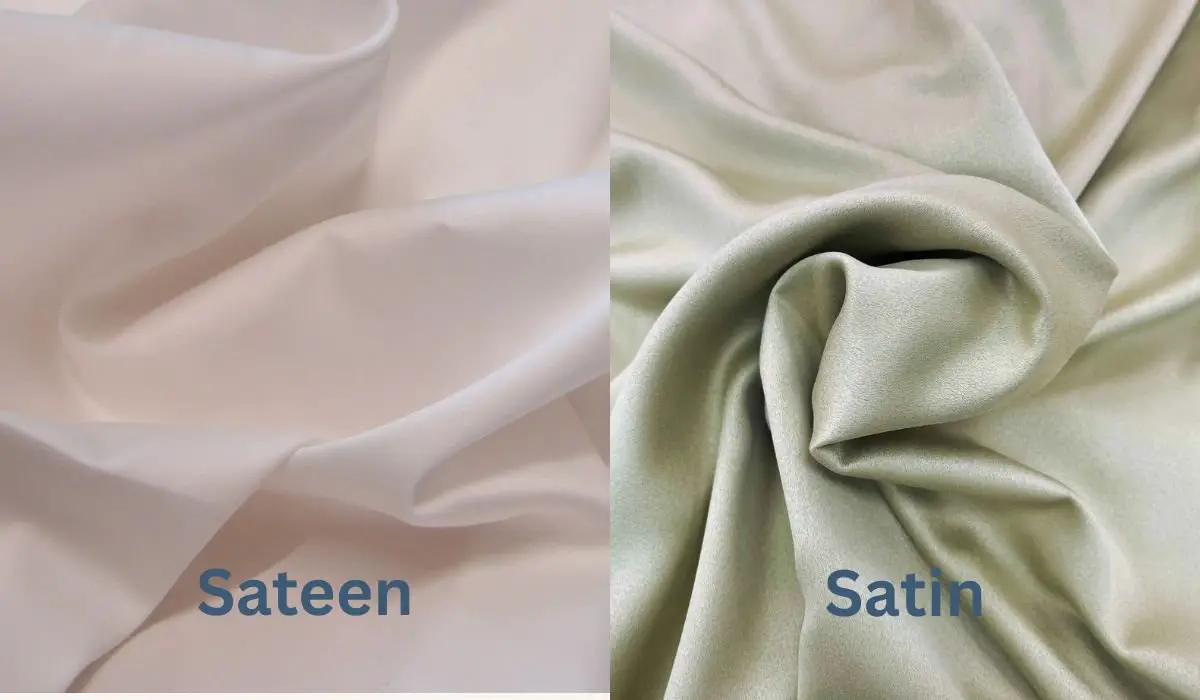
The similar names cause endless confusion. Let’s settle this once and for all.
Are Satin and Sateen the Same?
No, they’re not the same. While they share a similar weave structure, the key difference is the fiber content:
- Sateen: Cotton or cotton-blend fabric woven in a satin-style weave
- Satin: Silk, polyester, nylon, or rayon woven in a satin weave
What is the Difference Between Satin and Sateen?
| Aspect | Sateen | Satin |
|---|---|---|
| Fiber Type | Spun yarns (cotton) | Filament fibers (silk, polyester, nylon) |
| Weave Face | Weft-faced (horizontal threads dominate) | Warp-faced (vertical threads dominate) |
| Appearance | Subtle, sophisticated sheen | High-gloss, dramatic shine |
| Feel | Soft, less slippery, natural | Very smooth, slippery, synthetic feel (if polyester) |
| Breathability | Good (cotton breathes) | Poor (synthetic satin doesn’t breathe) |
| Durability | Excellent, machine-washable | Delicate, may need dry cleaning |
| Care | Easy, machine-wash and dry | Difficult, often requires hand-wash or dry-clean |
| Price | Moderate | Varies widely (silk is expensive, polyester is cheap) |
| Common Uses | Bedding, casual dresses, pajamas | Lingerie, evening wear, linings, accessories |
Is Satin or Sateen Better for Skin?
Sateen is generally better for skin health. Cotton sateen is a natural fiber that breathes, allowing moisture to evaporate. This helps prevent bacterial growth and reduces the likelihood of skin irritation or acne. Polyester satin, on the other hand, traps moisture and heat against your skin, which can lead to breakouts and irritation.
However, silk satin (not polyester) is actually excellent for skin and hair. Real silk is hypoallergenic, doesn’t absorb moisture from your skin, and reduces friction. If you’re comparing silk satin to cotton sateen for pillowcases, both are good choices, with silk having a slight edge for preventing hair frizz and face creases.
Are Sateen Sheets Good for Your Hair?
Yes, sateen sheets and pillowcases are good for your hair. The smooth surface creates less friction than rougher cotton weaves, which can help reduce hair breakage, tangles, and frizz while you sleep. However, silk or satin (the smooth synthetic kind) creates even less friction, making them slightly better for hair health. That said, sateen offers a great middle ground with more breathability than synthetic satin.
Sateen vs Silk: Which is Better?
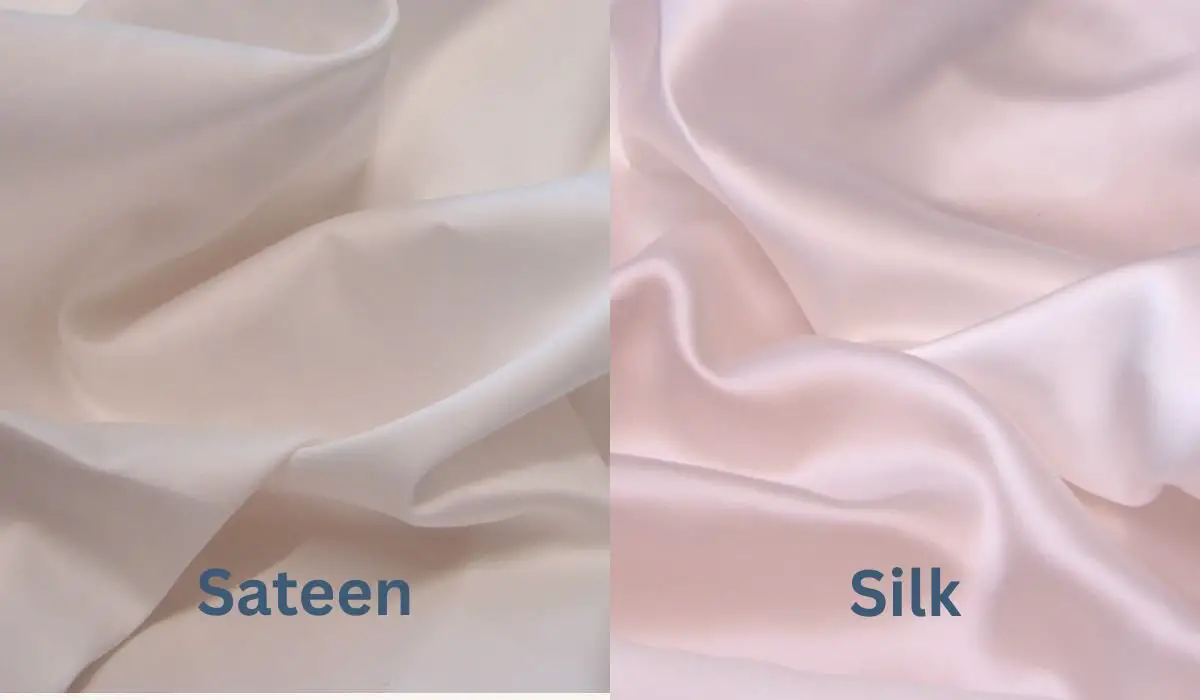
Is Sateen Better Than Silk?
This depends entirely on your priorities. Sateen isn’t “better” than silk in an absolute sense, but it offers different advantages. Here’s how they compare:
Sateen Advantages:
- Much more affordable (1/5 to 1/10 the cost of real silk)
- Machine-washable and easy to care for
- More durable and less prone to snags
- Warmer and cozier for cold sleepers
- Widely available in many colors and patterns
Silk Advantages:
- Superior temperature regulation (cool in summer, warm in winter)
- Better for skin and hair (less friction, hypoallergenic)
- More luxurious appearance and feel
- Naturally hypoallergenic and antimicrobial
- Lightweight yet warm
For most people, sateen offers the best value. It delivers 80% of silk’s luxury feel at 20% of the cost, with far easier maintenance. If budget isn’t a concern and you want the absolute best for skin, hair, and temperature regulation, go with real mulberry silk. But be prepared for higher costs and more delicate care requirements.
Environmental Impact and Sustainability
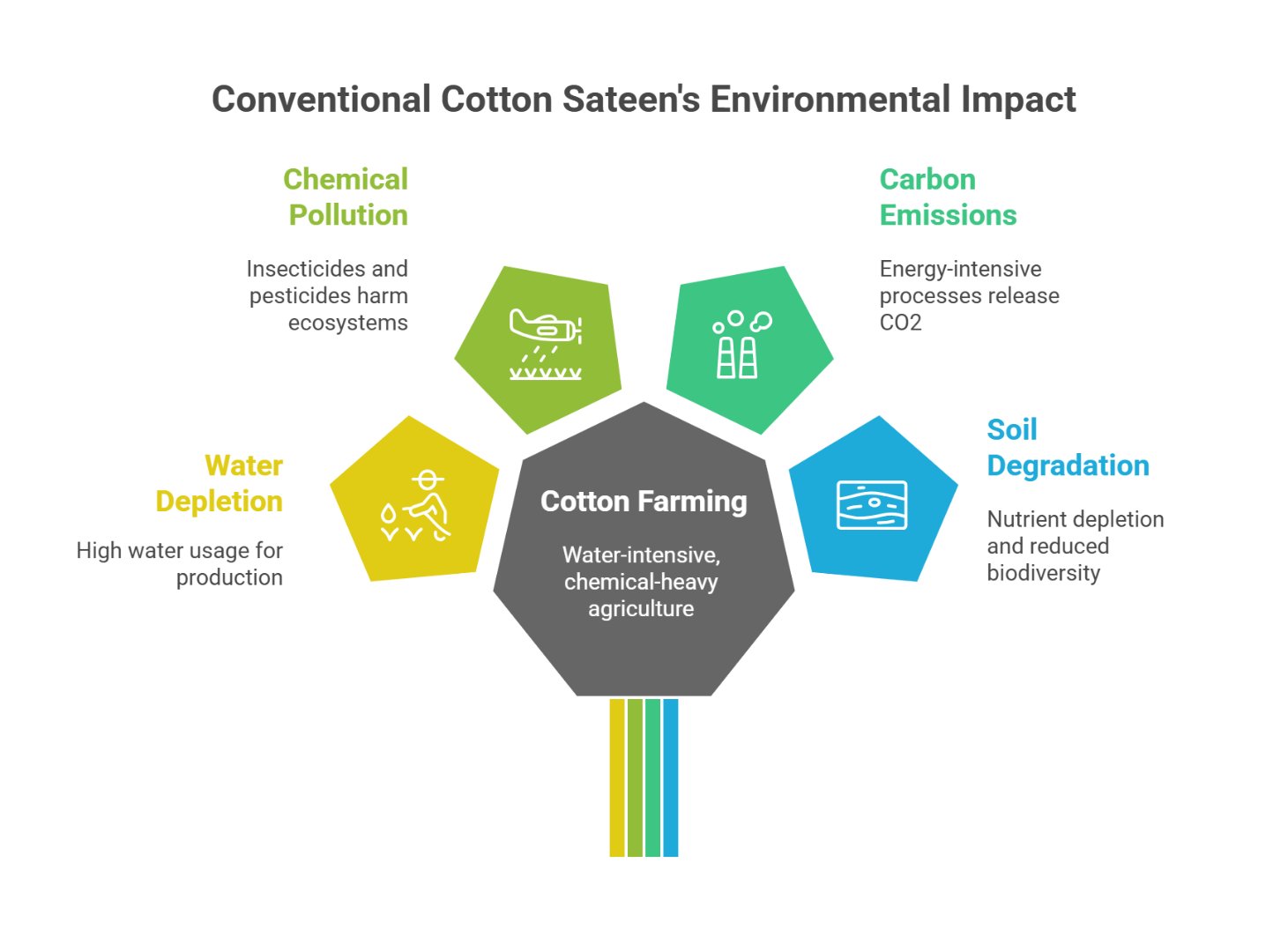
As consumers become more eco-conscious, understanding sateen’s environmental footprint becomes important. The sustainability of sateen depends heavily on how the cotton is grown and processed.
Conventional Cotton Sateen Environmental Concerns
Water Usage: Cotton is notoriously water-intensive. Growing enough cotton for one sateen sheet set can require 2,000-3,000 gallons of water. Irrigated cotton farming accounts for about 2.6% of global water use.
Chemical Use: Conventional cotton farming uses about 16% of the world’s insecticides and 6% of pesticides despite covering only 2.5% of agricultural land. These chemicals harm soil health, pollute water sources, and pose risks to farmworkers.
Carbon Footprint: From farming to manufacturing to transportation, conventional cotton sateen releases significant carbon dioxide. The energy-intensive processes of spinning, weaving, dyeing, and mercerization all contribute to greenhouse gas emissions.
Soil Degradation: Monoculture cotton farming depletes soil nutrients and reduces biodiversity. Heavy pesticide use further damages soil ecosystems.
Organic Cotton Sateen: The Sustainable Choice

Organic cotton sateen addresses many environmental concerns while maintaining the quality and feel you expect from sateen.
What Makes Cotton Sateen Organic?
Organic cotton is grown using methods that:
- Use no synthetic pesticides or fertilizers
- Rely on natural pest control methods
- Practice crop rotation to maintain soil health
- Use non-GMO seeds
- Employ sustainable water management
- Support fair labor practices
Environmental Benefits of Organic Sateen
Reduced Carbon Emissions: Organic cotton production releases 46% less CO2 compared to conventional cotton. This comes from avoiding synthetic fertilizer production and reducing tractor operations.
Lower Energy Use: Organic farming uses 62% less energy than conventional methods. No energy is needed to produce synthetic chemicals, and farming techniques require fewer machine operations.
Better Water Management: While organic cotton still requires significant water, many organic farms use more efficient irrigation methods and rely more heavily on rainfall. There’s also no water pollution from pesticide runoff.
Soil Health: Organic farming practices build healthy, living soil through composting, cover crops, and crop rotation. This creates a sustainable system that improves over time rather than depleting resources.
Biodiversity: Organic farms support diverse ecosystems with beneficial insects, birds, and microorganisms. This creates natural pest control and healthier growing conditions.
Is Organic Cotton Sateen Worth the Investment?
For many people, yes. Organic sateen typically costs 20-40% more than conventional sateen. However, you’re paying for:
- Reduced environmental impact
- Support for sustainable farming
- Protection of farmworker health
- Often higher quality (organic certification often correlates with better manufacturing standards)
- Peace of mind about chemical exposure
Calculate Your Impact
Want to see how choosing organic sateen affects your environmental footprint? Try our Sustainable Clothing Calculator to compare the environmental impact of different fabric choices.
Important Certifications to Look For

Not all organic or sustainable claims are equal. Third-party certifications provide verification that sateen meets specific standards.
GOTS (Global Organic Textile Standard)
GOTS is the gold standard for organic textiles. According to the official Global Organic Textile Standard, this certification covers the entire supply chain from harvesting to manufacturing. GOTS-certified sateen guarantees:
- At least 70% organic fibers (95% for “organic” label)
- No toxic chemicals in processing
- Environmental management throughout production
- Fair labor practices and safe working conditions
- No forced or child labor
OEKO-TEX Standard 100
This certification tests for harmful substances in finished textiles. OEKO-TEX certified sateen is free from:
- Formaldehyde
- Heavy metals
- Pesticides
- Chlorinated phenols
- Over 100 other potentially harmful substances
This certification is particularly important for bedding and children’s clothing where fabric contacts skin for extended periods.
Better Cotton Initiative (BCI)
BCI promotes better practices in conventional cotton farming. While not organic, BCI cotton uses less water and fewer chemicals than standard conventional cotton. It’s a good middle-ground option.
Fair Trade
Fair Trade certification focuses on social sustainability. It ensures farmers receive fair prices and workers have safe conditions and fair wages. Look for Fair Trade when you want to support ethical manufacturing.
Uses for Sateen Fabric
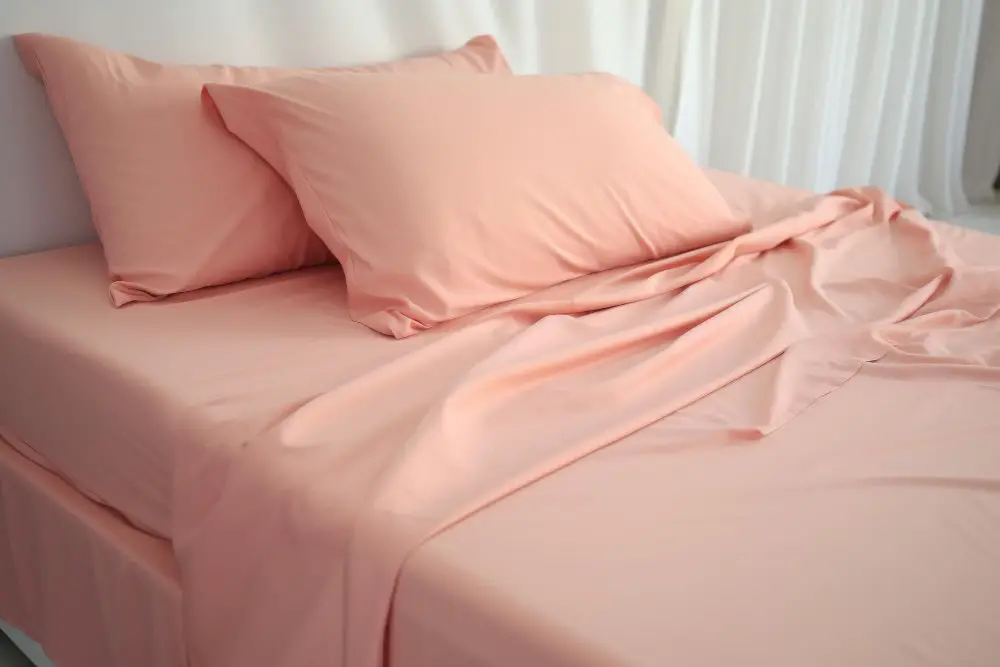
Sateen’s combination of softness, durability, and elegant appearance makes it versatile across many applications.
Bedding and Bed Linens
This is sateen’s most popular use. Sateen sheets offer luxury without the high price and maintenance requirements of silk. The smooth surface feels wonderful against skin, and the wrinkle-resistant properties mean your bed looks good with minimal effort.
Sateen Sheet Sets: Complete sets typically include a flat sheet, fitted sheet, and pillowcases. Thread counts between 300-500 offer the best balance of softness and durability.
Duvet Covers: Sateen duvet covers drape beautifully and resist wrinkles better than percale alternatives.
Pillowcases: The smooth surface is gentle on skin and hair, making sateen pillowcases popular among beauty-conscious consumers.
Shams: Decorative pillow shams in sateen add an elegant touch to bedroom décor with their subtle sheen.
Is Sateen Good for Summer?
Sateen is not ideal for summer or hot sleepers. The denser weave traps heat, making sateen warmer than percale or linen. If you sleep hot or live in a warm climate, consider lighter cotton weaves or look for lightweight sateen (around 300 thread count) which breathes better than heavier versions.
Fashion and Apparel
Sateen’s smooth drape and elegant appearance make it perfect for clothing:
Dresses: Sateen creates flowing, feminine dresses with beautiful drape. The wrinkle-resistance makes it practical for everyday wear. Floral prints on sateen look particularly vibrant due to the fabric’s smooth surface and good dye absorption.
Blouses and Shirts: Sateen blouses have a polished, professional appearance without looking too formal. The fabric moves nicely and resists wrinkles throughout the day.
Skirts: A-line and pleated skirts in sateen hold their shape while still flowing gracefully. The subtle sheen adds visual interest without being too shiny.
Pants and Trousers: Stretch sateen (with elastane) makes comfortable, fitted pants that look dressy but feel casual. The smooth surface resists pet hair and lint.
Jackets and Blazers: Lightweight sateen jackets offer a sophisticated alternative to heavier fabrics. The wrinkle-resistance makes them travel-friendly.
Linings: Sateen makes excellent lining for jackets, coats, and skirts. The smooth surface allows garments to slide on easily.
Sleepwear: Sateen pajamas and robes feel luxurious against skin. The fabric breathes better than synthetic satin while still feeling silky.
What to Sew With Sateen?
Sateen works well for:
- Gathered or pleated garments (the drape creates beautiful fullness)
- Simple designs where fabric quality shines
- Items that benefit from a subtle sheen (party dresses, evening wear)
- Projects requiring wrinkle resistance (travel clothing)
- Garments with bias cuts (sateen drapes beautifully on the bias)
Other Applications
Curtains and Drapes: Sateen curtains hang in elegant folds and the subtle sheen adds richness to room décor. The heavier weight provides good light blocking.
Upholstery: While not as common as other upholstery fabrics, sateen works for decorative throw pillows, cushion covers, and light-use furniture pieces.
Table Linens: Sateen tablecloths and napkins create a refined table setting. The wrinkle-resistance is practical for entertaining.
Quilting: Some quilters use sateen for backing fabric. The smooth texture feels nice against skin, though the weave isn’t ideal for hand-quilting.
Complete Care Guide for Sateen Fabric

Proper care extends the life of sateen and maintains its soft, lustrous appearance. The good news? Sateen is relatively easy to care for compared to silk or satin.
Washing Sateen
- Check the Care Label: Always start by reading manufacturer instructions. Some sateen may have specific requirements based on dyes or finishes.
- Separate by Color: Wash darks separately from lights to prevent color transfer. Wash sateen separately from rough fabrics like towels or jeans to avoid abrasion.
- Pre-treat Stains: For fresh stains, blot (don’t rub) with a damp cloth. Pre-treat with mild detergent or a natural solution like diluted white vinegar.
- Choose Cool to Warm Water: Use cool water (30°C/85°F) for colored sateen and warm water (40°C/105°F) for whites. Avoid hot water as it can cause shrinkage and fade colors.
- Select Gentle Cycle: Use the delicate or gentle cycle on your washing machine. The slow agitation and reduced spin speed protect the fabric from damage.
- Use Mild Detergent: Choose a gentle, liquid detergent free from bleach and optical brighteners. Avoid harsh chemicals that can damage cotton fibers.
- Skip Fabric Softener: Sateen doesn’t need fabric softener. In fact, fabric softener can build up on the fabric and reduce absorbency. If desired, add white vinegar to the rinse cycle instead.
Can You Wash Cotton Sateen?
Yes, absolutely. Cotton sateen is machine-washable, which is one of its biggest advantages over silk or delicate satin. Just follow the guidelines above for best results.
Does Sateen Shrink After Washing?
Cotton sateen can shrink slightly, especially during the first wash. Expect 2-5% shrinkage with the first washing if the fabric wasn’t pre-shrunk during manufacturing. To minimize shrinkage:
- Use cold or warm water (never hot)
- Avoid high heat in the dryer
- Look for pre-shrunk or sanforized sateen
- Consider sizing up if shrinkage is a concern
Does 100% Cotton Sateen Shrink?
Yes, pure cotton sateen will shrink somewhat, usually 3-5% with the first wash and minimal additional shrinkage after that. This is normal for natural cotton fibers. Blended sateen with polyester shrinks less.
Drying Sateen
Air Drying (Recommended): Hang sateen items on a clothesline or lay flat to dry. Keep them out of direct sunlight to prevent fading. Air drying maintains fabric integrity and prevents shrinkage.
Machine Drying: If you must use a dryer, choose low heat and remove items while still slightly damp. High heat damages cotton fibers and can cause excessive shrinkage. Overdrying also makes the fabric stiff.
Can You Put Sateen in the Dryer?
Yes, but use caution. Always use low heat and don’t overdry. Remove sateen from the dryer while items are still slightly damp to prevent wrinkles and stiffness.
Can I Tumble Dry Cotton Sateen?
Yes, cotton sateen can be tumble dried on low heat. However, air drying extends the fabric’s lifespan and maintains its softness better than machine drying.
Ironing Sateen
One of sateen’s best features is its natural wrinkle resistance. Often, you won’t need to iron at all. If you do:
- Iron while fabric is still slightly damp
- Use medium heat (cotton setting)
- Iron on the reverse side to protect the sheen
- Use steam for stubborn wrinkles
- For bedding, fit damp sheets onto the bed and smooth by hand to avoid ironing
Storing Sateen
Store sateen in a cool, dry place away from direct sunlight. Fold neatly or roll to prevent permanent creases. For long-term storage, use breathable cotton bags rather than plastic to prevent mildew. Ensure items are completely dry before storing.
Stain Removal for Sateen
Oil-Based Stains: Sprinkle baking soda or cornstarch on fresh oil stains to absorb the oil. After 30 minutes, brush off and treat with dish soap before washing.
Protein-Based Stains (blood, sweat): Soak in cold water (never hot, which sets protein stains). Apply enzyme-based stain remover and wash in cool water.
Tannin Stains (coffee, tea, wine): Blot immediately. Mix equal parts white vinegar and water, apply to stain, then wash normally.
Dye Transfer: If colors bleed onto sateen, try soaking in oxygen bleach (safe for colors) for several hours before rewashing.
Natural Stain Removers for Sateen
White Vinegar: Add 1/3 cup to the rinse cycle to remove odors, brighten colors, and soften fabric naturally. It also helps remove detergent residue.
Baking Soda: Add 1/2 cup directly to the drum before adding sateen. It boosts detergent effectiveness and acts as a natural fabric freshener without harsh chemicals.
Do Sateen Sheets Get Softer After Washing?
Yes! One of sateen’s best qualities is that it gets softer with each wash. The agitation and water relax the cotton fibers, making them more pliable. Most sateen reaches peak softness after 3-5 washes. This is why you shouldn’t judge new sateen by its initial feel. Give it time to break in.
Advantages and Disadvantages of Sateen Fabric
Every fabric has strengths and weaknesses. Here’s an honest look at both sides of sateen.
Advantages
- Exceptional Softness: Sateen ranks among the softest cotton fabrics available. The smooth surface feels luxurious against skin.
- Elegant Appearance: The subtle sheen gives sateen a polished, sophisticated look that elevates any bedroom or garment.
- Wrinkle Resistant: The weave structure naturally resists wrinkles, making sateen low-maintenance and always looking neat.
- Beautiful Drape: Sateen flows and hangs gracefully, creating elegant folds in curtains and fluid movement in clothing.
- Improves With Washing: Unlike many fabrics that deteriorate over time, quality sateen gets softer with repeated washing.
- Machine Washable: Easy care compared to silk or satin. Just toss in the washing machine and enjoy.
- Affordable Luxury: Provides a silk-like feel at a fraction of the cost, making luxury accessible.
- Good Color Retention: Especially when mercerized, sateen holds dye well and maintains vibrant colors through many washes.
- Versatile: Works for bedding, fashion, home décor, and more. One fabric, many applications.
- Natural and Breathable: When made from 100% cotton, sateen is a natural fiber that allows some airflow.
Disadvantages
- May Pill Over Time: The long thread floats on the surface can break and pill, especially with friction or rough handling.
- Prone to Snags: The loose weave makes sateen more vulnerable to snags from sharp objects or pet claws.
- Retains Heat: Not ideal for hot sleepers or warm climates. The denser weave traps more body heat than percale or linen.
- Less Durable Than Percale: The weave structure isn’t as strong as tight plain weaves. Heavy use can cause wear faster.
- Can Shrink: Cotton sateen typically shrinks 3-5% with first washing. Always account for this when buying.
- Shows Wrinkles When Damp: While generally wrinkle-resistant when dry, sateen can wrinkle if not removed from the dryer promptly.
- Moderate Breathability: More breathable than synthetics but less than plain-weave cottons or linen.
- May Feel Too Warm: The cozy warmth that’s perfect in winter can be uncomfortable in summer.
- Quality Varies Widely: Not all sateen is created equal. Cheap sateen can be disappointing, while quality sateen costs more.
- Environmental Concerns: Unless organic, conventional cotton sateen has significant environmental impacts from pesticide use and water consumption.
Is Sateen Itchy?
No, sateen is not itchy. In fact, it’s one of the smoothest cotton fabrics available. The long thread floats and soft cotton fibers create a surface that glides against skin without irritation. If sateen feels itchy to you, it’s likely low-quality fabric with short, rough fibers or chemical treatments causing the problem.
Is Sateen Hypoallergenic?
Pure cotton sateen is naturally hypoallergenic. Cotton doesn’t harbor dust mites as readily as some materials, and the tight weave helps prevent allergen accumulation. However, “hypoallergenic” isn’t an absolute term. If you’re very sensitive, look for:
- OEKO-TEX certified sateen (free from harmful chemicals)
- Organic cotton sateen (no pesticide residues)
- Undyed or naturally dyed options if you react to synthetic dyes
Does Sateen Have Chemicals?
Conventional sateen may contain chemical residues from:
- Pesticides used in cotton farming
- Dyes and finishing treatments
- Mercerization chemicals (though these should be fully rinsed out)
- Sizing agents or wrinkle-resistant treatments
To minimize chemical exposure, choose organic, GOTS-certified, or OEKO-TEX certified sateen, and always wash new items before use.
How to Choose Quality Sateen

Understanding Thread Count
Thread count measures how many threads fit into one square inch of fabric. Higher isn’t always better with sateen.
Sweet Spot: 300-500 thread count
- Below 300: May feel rough or thin
- 300-400: Good balance of softness, breathability, and durability
- 400-500: Very soft, slightly less breathable
- Above 600: Often marketing gimmicks using multi-ply threads; may feel less soft despite higher numbers
Find Your Perfect Thread Count
Use our Thread Count Calculator to find the ideal thread count based on your preferences and climate.
Fiber Quality Matters More Than Thread Count
A 300 thread count Egyptian cotton sateen beats a 600 thread count short-staple cotton sateen every time. Look for:
- Long-staple cotton: Creates stronger, smoother, more durable fabric
- Egyptian or Pima cotton: Premium options with superior softness
- Combed cotton: Removes short fibers for smoother finish
- Single-ply threads: Better quality than multi-ply at same thread count
Is Sateen Expensive?
Sateen falls in the moderate to high price range for cotton fabrics. Expect to pay:
- Budget Sateen: $30-60 for a queen sheet set (may be lower quality)
- Mid-Range Sateen: $60-150 for a queen sheet set (good quality, likely to last)
- Luxury Sateen: $150-300+ for a queen sheet set (premium cotton, often organic or Egyptian)
For clothing, sateen typically costs $8-25 per yard depending on quality and whether it’s organic.
What to Look For
When shopping for sateen, check for:
- Fiber content: 100% cotton is ideal; avoid high polyester blends
- Weave quality: Feel the fabric; it should be smooth with no rough patches
- Even color: Look for consistent dye with no streaks or blotches
- Weight: Quality sateen feels substantial, not flimsy
- Certifications: GOTS, OEKO-TEX, or organic certification adds value
- Return policy: Good retailers allow returns if you’re not satisfied
Red Flags to Avoid
- Thread counts above 600 (likely inflated with multi-ply threads)
- Extremely low prices (may indicate poor quality cotton or unethical production)
- Vague descriptions like “sateen-like” or “satin feel” (probably not real sateen)
- No fiber content listed (should be transparent about materials)
- Polyester-cotton blends marketed as “cotton sateen” (less breathable)
What is the Alternative to Sateen?
If sateen doesn’t meet your needs, consider:
- Percale: Cooler, crisper, more breathable cotton weave
- Linen: Most breathable natural fiber, perfect for hot sleepers
- Bamboo fabric: Silky-soft like sateen but more moisture-wicking
- Silk: Ultimate luxury if budget allows
- Jersey: Stretchy, soft cotton knit for casual comfort
Are Bamboo or Sateen Sheets Better?
Both have advantages:
Choose bamboo if you: Sleep hot, want maximum moisture-wicking, prefer an even softer feel, care about sustainability (bamboo grows faster than cotton)
Choose sateen if you: Want proven durability, prefer traditional cotton, sleep cool, want easier care (bamboo can be delicate), prefer a less slippery surface
Frequently Asked Questions
Conclusion
After exploring every aspect of sateen fabric, from its ancient origins to modern sustainability concerns, we’ve covered what makes this cotton weave special. Let’s bring it all together with practical takeaways.
Key Takeaways
Remember These Points
- Sateen is a weave, not a material: It’s cotton woven in a 4-over-1-under pattern that creates a smooth, lustrous surface
- Perfect for cold sleepers: The dense weave retains heat, making sateen ideal for cooler climates and winter months
- Gets better with age: Unlike many fabrics, quality sateen becomes softer and more comfortable with each wash
- Easy maintenance: Machine-washable and wrinkle-resistant, sateen offers luxury without the fuss of silk
- Choose organic when possible: Organic cotton sateen reduces environmental impact by 46% in carbon emissions and uses 62% less energy
- Thread count sweet spot: Look for 300-500 thread count for the best balance of softness, breathability, and durability
Who Should Choose Sateen?
Sateen is your best choice if you:
- Value softness and smooth texture above all else
- Sleep cold or live in a cooler climate
- Want luxurious bedding without silk prices
- Prefer low-maintenance, wrinkle-resistant fabrics
- Appreciate subtle elegance over high-gloss shine
- Need versatile fabric for both bedding and clothing
- Want fabric that improves over time
Who Should Look Elsewhere?
Consider alternatives if you:
- Sleep hot or live in warm climates (try percale or linen)
- Prioritize maximum breathability (choose plain-weave cotton)
- Need extremely durable fabric for heavy use (percale lasts longer)
- Prefer crisp, cool textures (percale is your fabric)
- Want the absolute lightest-weight bedding (try cotton voile or bamboo)
Making the Most of Your Sateen
To get the longest life and best performance from sateen fabric:
- Invest in quality: Good sateen costs more upfront but lasts years longer and feels dramatically better
- Look for certifications: GOTS or OEKO-TEX certified sateen guarantees quality and safety
- Care properly: Cool water, gentle cycle, low heat drying, and prompt removal from the dryer
- Give it time: Don’t judge sateen by the first use; it needs 3-5 washes to reach peak softness
- Consider the season: Layer sateen with lighter blankets in summer, use alone in spring and fall
- Rotate sets: If using for bedding, have two sets to rotate while washing, extending life of both
The Bottom Line
Sateen represents the perfect middle ground in the luxury fabric world. It delivers silk-like softness and elegance at cotton prices with easy cotton care. While not perfect for everyone (especially hot sleepers), sateen excels at providing affordable luxury that gets better with time.
For most people seeking soft, comfortable bedding or elegant clothing fabrics, sateen offers outstanding value. The combination of natural cotton fibers, sophisticated weave structure, and practical maintenance makes it hard to beat. Choose organic when possible to support sustainable farming, and invest in quality over quantity.
Whether you’re shopping for sateen sheets to transform your bedroom into a luxury retreat, or fabric for that perfect dress, understanding what makes sateen special helps you make informed decisions. Now that you know exactly what sateen is, how it’s made, and how to care for it, you’re ready to experience this beautiful fabric for yourself.
Sweet dreams (or stylish days) in your new sateen!

